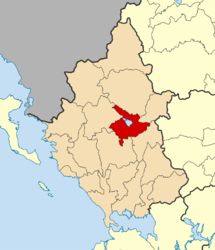
Back يوانينا Arabic يوانينا ARZ Ioánina AST Yanina Azerbaijani Янина (ҡала) Bashkir Яніна (горад) Byelorussian Яніна (горад) BE-X-OLD Янина Bulgarian ইওয়ান্নিনা Bengali/Bangla Ioànnina Catalan
Ioannina
Ιωάννινα | |
|---|---|
 Clockwise from top: Panoramic view of Lake Pamvotis and the city of Ioannina from Mitsikeli, Old Town, Municipal Clock Tower of Ioannina, Municipal Ethnographic Museum of Ioannina, Kaplaneios School, Ferry to the Island, Post Office, and the Castle of Ioannina. | |
| Coordinates: 39°39′49″N 20°51′08″E / 39.66361°N 20.85222°E | |
| Country | Greece |
| Administrative region | Epirus |
| Regional unit | Ioannina |
| Government | |
| • Mayor | Thomas Begkas[1] (since 2023) |
| Area | |
• Municipality | 403.32 km2 (155.72 sq mi) |
| • Municipal unit | 47.44 km2 (18.32 sq mi) |
| • Community | 17.355 km2 (6.701 sq mi) |
| Elevation | 480 m (1,570 ft) |
| Population (2021)[2] | |
• Municipality | 113,978 |
| • Density | 280/km2 (730/sq mi) |
| • Municipal unit | 81,627 |
| • Municipal unit density | 1,700/km2 (4,500/sq mi) |
| • Community | 64,896 |
| • Community density | 3,700/km2 (9,700/sq mi) |
| Demonym(s) | Yanniote (Gianniote)/ Ioannite (formal) |
| Time zone | UTC+2 (EET) |
| • Summer (DST) | UTC+3 (EEST) |
| Postal code | 45x xx |
| Area code(s) | 26510 |
| Vehicle registration | ΙΝ |
| Website | ioannina |
Ioannina (Greek: Ιωάννινα Ioánnina [i.oˈa.ni.na] ⓘ), often called Yannena (Γιάννενα Yánnena [ˈʝa.ne.na]) within Greece, is the capital and largest city of the Ioannina regional unit and of Epirus, an administrative region in northwestern Greece. According to the 2021 census, the city population was 64,896 while the municipality had 113,978 inhabitants. It lies at an elevation of approximately 500 metres (1,640 feet) above sea level, on the western shore of Lake Pamvotis (Παμβώτις). Ioannina is located 410 km (255 mi) northwest of Athens, 260 kilometres (162 miles) southwest of Thessaloniki and 80 km (50 miles) east of the port of Igoumenitsa on the Ionian Sea.
The city's foundation has traditionally been ascribed to the Byzantine Emperor Justinian in the 6th century AD, but modern archaeological research has uncovered evidence of Hellenistic settlements. Ioannina flourished in the late Byzantine period (13th–15th centuries). It became part of the Despotate of Epirus following the Fourth Crusade and many wealthy Byzantine families fled there following the 1204 sack of Constantinople, with the city experiencing great prosperity and considerable autonomy, despite the political turmoil. Ioannina surrendered to the Ottomans in 1430 and until 1868 it was the administrative center of the Pashalik of Yanina. In the period between the 18th and 19th centuries, the city was a major center of the modern Greek Enlightenment.[3][4][5][6] Ioannina was ceded to Greece in 1913 following the Balkan Wars.
The city is also characterized by various green areas and parks, including Molos (Lake Front), Litharitsia Park, Pirsinella Park (Giannotiko Saloni), Suburban Forest. There are two hospitals, the General Hospital of Ioannina "G. Hatzikosta", and the University Hospital of Ioannina. It is also the seat of the University of Ioannina. The city's emblem consists of the portrait of the Byzantine Emperor Justinian crowned by a stylized depiction of the nearby ancient theater of Dodona.
- ^ "Municipality of Ioannina, Municipal elections – October 2023". Ministry of Interior.
- ^ "Αποτελέσματα Απογραφής Πληθυσμού - Κατοικιών 2021, Μόνιμος Πληθυσμός κατά οικισμό" [Results of the 2021 Population - Housing Census, Permanent population by settlement] (in Greek). Hellenic Statistical Authority. 29 March 2024.
- ^ Sakellariou M. V. Epirus, 4000 years of Greek history and civilization Archived 30 September 2023 at the Wayback Machine. Ekdotikē Athēnōn, 1997, ISBN 978-960-213-371-2 p. 268
- ^ Fleming Katherine Elizabeth. The Muslim Bonaparte: diplomacy and orientalism in Ali Pasha's Greece. Princeton University Press, 1999. ISBN 978-0-691-00194-4. p. 63-66
- ^ The Era of Enlightenment (late 7th century – 1821) Archived 26 May 2011 at the Wayback Machine. Εθνικό Kέντρο Bιβλίου, p. 13
- ^ Υπουργείο Εσωτερικών, Αποκέντρωσης και Ηλεκρονικής Διακυβέρνησης Περιφέρεια Ηπείρου Archived 29 June 2010 at the Wayback Machine: "Στη δεκαετία του 1790 ο νεοελληνικός διαφωτισμός έφθασε στο κορύφωμά του. ΦορέαA_1του πνεύματος στα Ιωάννινα είναι ο Αθανάσιος ΨαλίδαA_."

